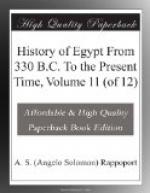[Illustration: 316.jpg COINS OF JUSTINIAN]
The Emperor Mauricius was murdered by Phocas, who, in 602, succeeded him on the throne of Constantinople. No sooner did the news of his death reach Persia than Chosroes, the son of Hormuz, who had married Maria, the daughter of Mauricius, declared the treaty with the Romans at an end, and moved his forces against the new emperor, the murderer of his father-in-law. During the whole of his reign Constantinople was kept in a state of alarm and almost of siege by the Persians; and the crimes and misfortunes of Phocas alike prepared his subjects for a revolt. In the seventh year Alexandria rebelled in favour of the young Heraclius, son of the late prefect of Cyrene; and the patriarch of Egypt was slain in the struggle. Soon afterwards Heraclius entered the port of Constantinople with his fleet, and Phocas was put to death after an unfortunate reign of eight years, in which he had lost every province of the empire.
During the first three years of the reign of Heraclius, Theodoras was Bishop of Alexandria; but upon his death the wishes of the Alexandrians so strongly pointed to John, the son of the prefect of Cyprus, that the emperor, yielding to their request, appointed him to the bishopric. Alexandria was not a place in which a good man could enjoy the pleasures of power without feeling the weight of its duties. It was then suffering under all those evils which usually befall the capital of a sinking state. It had lost much of its trade, and its poorer citizens no longer received a free supply of grain. The unsettled state of the country was starving the larger cities, and the population of Alexandria was suffering from want of employment. The civil magistrates had removed their palace to a distance. But the new bishop seemed formed for these unfortunate times, and, though appointed by the emperor, he was in every respect worthy of the free choice of the citizens. He was foremost in every work of benevolence and charity. The five years of his government were spent in lightening the sufferings of the people, and he gained the truly Christian name of John the Almsgiver. Beside his private acts of kindness he established throughout the city hospitals for the sick and almshouses for the poor and for strangers, and as many as seven lying-in hospitals for poor women. John was not less active in outrooting all that he thought heresy.
The first years of the reign of Heraclius are chiefly marked by the successes of the Persians. While Chosroes, their king, was himself attacking Constantinople, one general was besieging Jerusalem and a second overrunning Lower Egypt. Crowds fled before the invading army to Alexandria as a place of safety, and the famine increased as the province of the prefect grew narrower and the population more crowded. To add to the distress the Nile rose to a less height than usual; the seasons seemed to assist the enemy in the destruction of Egypt. The patriarch John, who had been sending




